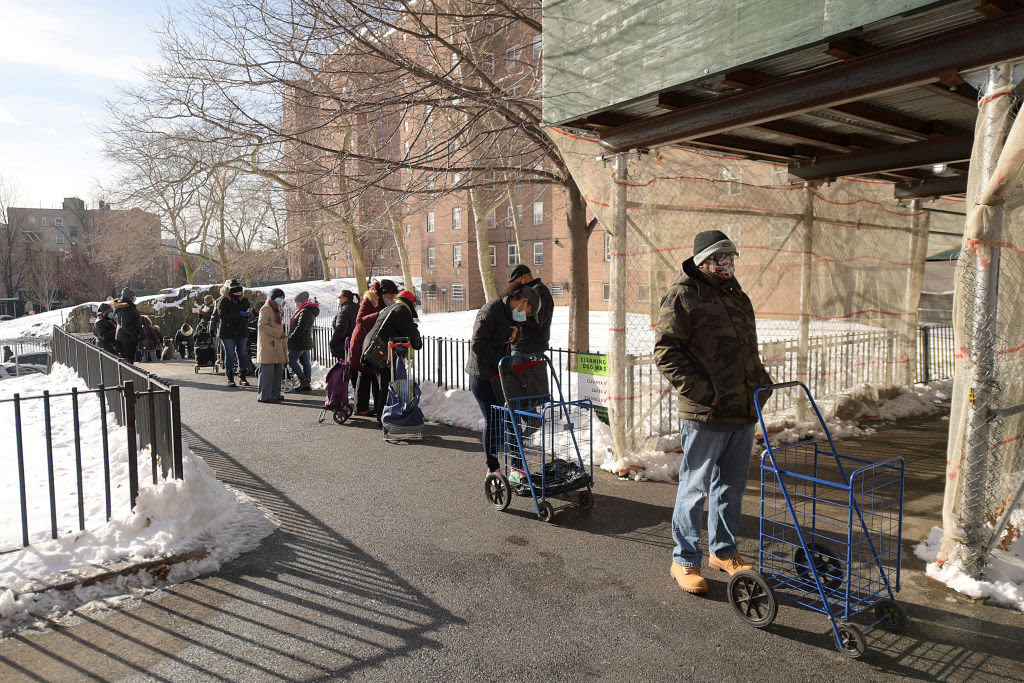Millions of Americans report not having enough money to pay for food during the pandemic.
Michael Loccisano | Getty Images Entertainment | Getty Images
The latest Covid relief package expands food benefits, giving further aid to millions of Americans who are facing financial difficulty because of the coronavirus pandemic.
The $900 billion stimulus bill signed by President Donald Trump on Sunday allocates $13 billion for the Supplemental Nutrition Assistance Program, or SNAP. Starting on Jan. 1, benefits will be boosted by 15% a month for all recipients.
In addition, the bill earmarks millions of dollars to support food banks and programs such as Meals on Wheels. It also makes changes to the eligibility requirements for SNAP that will help Americans in need take advantage of the program.
More From Invest in You:
It’s a tough outlook for graduates in the Class of 2020
Many college graduates are relying on unemployment to pay the bills
Internships canceled? College students must get creative and adapt
Food insecurity has become a widespread issue amid the Covid crisis, especially after relief such as $1,200 direct checks and the additional $600 per week in unemployment benefits extended by the CARES Act in March ran out. At the end of September, nearly 20% of all adults and 40% of those in a family where at least one adult lost a job reported food insecurity, according to the Urban Institute.
“Food hardship has increased significantly during Covid-19, especially for households headed by Black and Latinx adults,” said Luis Guardia, president of the Food Research & Action Center. “SNAP benefits can help provide the nutrition those households need.”
Here’s what you need to know.
How did the bill change SNAP?
Thanks to the stimulus package, all SNAP recipients will receive a 15% boost in monthly benefits that will run from January 2021 to June 2021. That amounts to around $25 more per person, per month, said Lisa Davis, the senior vice president of the No Kid Hungry Campaign. A family of four will get an extra $100 a month.
The $300 a week federal unemployment boost in the bill will also not count toward people’s income when they apply for SNAP, making more jobless people able to qualify.
“This helps to make sure that some struggling families won’t lose food assistance because they are receiving modest unemployment benefits,” Davis said.
The legislation also makes it easier for low-income college students to qualify, including, for example, suspension of a previous work requirement.
Among other changes, the bill also allocates $5 million to the Department of Agriculture for it to expand people’s ability to order their food online.
How do I know if I qualify?
You’ll need to apply.
Many people don’t try to access the benefit because they assume they’re ineligible or worry about the stigma, said Carrie R. Welton, director of policy at advocacy group The Hope Center for College, Community and Justice.
“People will bring their own shame into this, but these are taxpayer resources,” Welton said. “This pandemic is not anyone’s fault.”
SNAP has rules around how much you can own in assets and earn in income to qualify. But certain expenses, including your rent and childcare costs, can be deducted, Welton said. And again, the recent stimulus package excludes the federal unemployment boost from people’s income.
How do I apply?
The Center on Budget and Policy Priorities has a state-by-state guide to applying for SNAP benefits.
The Department of Agriculture, which runs the program, also has resources to get you started.
If accessing Internet is a problem right now, you can look up your state’s SNAP phone number on the DOA’s website. In many states, you can also dial 211 to apply.
How much could I get?
Under the new rules, an individual could get up to $234 a month. A family of four could get as much as $782 through June.
In some states, the maximum benefit is higher. For example, a family of four in Hawaii may receive a monthly benefit of $1,440.
The money will be sent to you each month on a EBT card, which acts like a debit card. People typically get the money in less than 30 days, but those with little to no income could get their benefits within a week.
What if I have young children at home?
The Pandemic-EBT program was created during the health crisis to provide food to families who lost access to free or reduced-price school meals. In an average month, it gives out an additional $114 per child, per month. That’s on top of regular SNAP benefits.
“This is a huge benefit increase for them,” said Lauren Bauer, a fellow in economic studies at the Brookings Institution.
A shocking number of children are facing hunger today.
Lisa Davis
senior vice president of the No Kid Hungry Campaign
The latest relief bill gives states some additional flexibilities to support the distribution of P-EBT benefits to school-age children and expands the program for children younger than 6 years old through September 2021, providing a lifeline for young children when childcare is closed.
Generally, benefits will be automatically sent to eligible children such as those already receiving free or reduced school lunch — enrollment is not required. The money will either be loaded on a previous EBT card or on a newly issued one.
“A shocking number of children are facing hunger today,” said Davis, adding that about 17 million American children didn’t have enough to eat in 2020.
Where can I use my SNAP benefits?
The Department of Agriculture has an interactive map where you can search for retailers that accept SNAP benefits.
Many farmers’ markets also accept the card, and you can search for one near you at the DOA’s website.
“And thanks to rapid expansion of a small pilot program in the wake of COVID, most states allow for online grocery programs,” Davis said.
